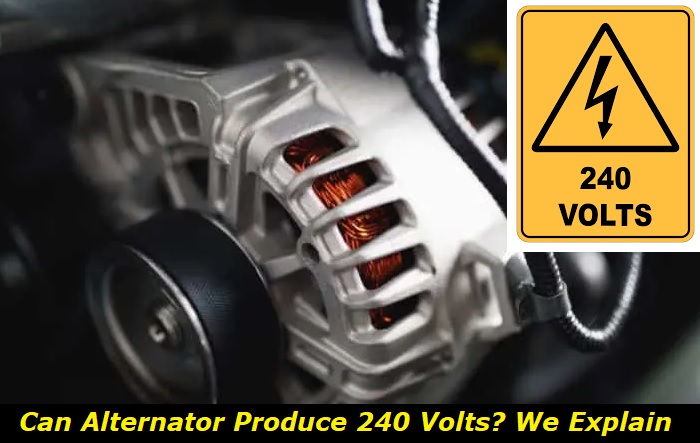It's possible to make an alternator generate 240 volts, but it only works for big alternators that have such a capacity. You could also make it happen by increasing the alternator's speed, connecting the unit's output to a compatible step-up transformer, using a static inverter, manipulating the unit with a voltage regulator, etc.
Electrical power supply problems highlights
- DIY repairs:possible (sometimes)
- Tools needed:electrical tools,basiccar repair tools
- Commonreasons:battery or alternator problems, wiring issues, power distribution problems
- Time to repair:2 - 5 hours
- Price for parts:$10 - $350
- Can you drive?In most cases, no
- Alternative solutions:jumping, roadside assistance

Background To the Alternator
It wasn't till the 60s that cars started utilizing alternators. They were using a combination of DC dynamo generators and commutators. The introduction of alternators to the automotive industry was made possible because of the availability and affordability of silicon-diode rectifiers.
The need for more power to operate cars made the development of alternators necessary. And its importance grew with the addition of advanced vehicle features. For example; bigger headlights, HVAC systems, electric wipers, etc.
What Are Alternators?
As stated earlier, many car users think that it's the battery that gives all the electrical power their vehicles utilize. But it's the alternator that keeps the electronic systems and components powered. This small cylindrical generator is under the car's hood and is attached to the engine.
The alternator is one of the major components of a car's electric charging system. The other parts are the voltage regulator and battery.
An alternator supplies the electrical energy that will be stored in the battery. It's the role of this unit to receive mechanical power from a serpentine belt or drive belt linked to the engine's crankshaft pulley. It will then transform this power into electricity.
An alternator should typically generate around 14 volts if it's a 12-volt system. It should be a little more than the battery's output so that it can beat the battery's internal resistance and make it juice up. Anything lower than 13 volts means that your voltage regulator isn't functioning well.
Older alternator models featured electro-mechanical voltage regulators that could be tweaked, but the new models utilize solid-state electronics that need to be swapped out when they experience failure.
Note: Nearly all light trucks and passenger vehicles utilize alternators that feature "claw-pole" or Lundahl field construction.
How an Alternator Operates in a Car
Your car's alternator keeps the vehicle running by providing the 12-volt electric field that's required to power up the vehicle's computer, ignition, and accessories.
An alternator is excited by an external voltage that's received from the battery by its stator windings. The excitation (initial) voltage will then be used to produce a magnetic field in the rotor. The rotor will in turn trigger a voltage in the stator windings.
The stator's triggered voltage will vary as the rotor turns when the alternator is connected to the running engine. Alternating current (AC) will be generated and transformed to direct current (DC) by the rectifier. The alternator's output will be utilized in charging the battery and powering the vehicle's electrical systems.
When the Alternator or Battery Fails
A non-functioning alternator will trigger the car to run on the battery directly for a period. A car shouldn't be allowed to run only on its alternator because there won't be a way for the engine to restart when it's turned off. This is because the battery is an indispensable buffer for the alternator.
All the current that's utilized by your car is ultimately derived from the alternator. The battery only gives power when the alternator doesn't have enough juice to start the vehicle.
Your car can run solely on the alternator, but it's better to resolve the situation before you get stuck. The car's system should be made to run normally as engineered.
An alternator can overcharge the vehicle's battery when it experiences internal failure. For example, the "ground" lead that runs from the field slip ring shorting to the ground and making the alternator run steadily at full current. The internal regulator can also malfunction, leading to an overcharged battery.
The battery voltage sensing wiring can have a bad connection and make the alternator "sense" a low battery voltage. This will make the unit give the battery a constant full charge.
Note: Battery overcharging can occur in other ways depending on the vehicle's make and model.
When To Replace a Bad Alternator
An alternator can last 200,000-300,000 miles or more. You can just base its expected lifespan on that of the vehicle. The unit will keep working well until there's a fault in a mechanical component, the diodes burn out, a field coil goes open circuit, etc. The issue will hinder the unit from delivering optimal power.
You should replace the unit when it starts showing signs of failure. But the car may stall or run roughly after swapping out a bad alternator. This is because of the mandatory disconnection of the battery during the alternator's replacement process.
The vehicle's control system will lose its history and settings for optimal fuel-air ratio after an alternator swap. You may have to run the vehicle for 30-60 minutes for things to come back to normal.
How To Make Your Car's Alternator Produce 240 Volts Effectively
You can see that alternators really generate alternating current, but it's decreased and transformed to direct current. This is in contrast to a generator which generates DC.
The alternator's voltage regulator determines the alternator's output and it maintains the voltages within specific ranges. In turn, the alternator's speed influences the voltage amount. The higher the speed, the more power produced. Some power may be lost in the rectifier circuit as it transforms the alternator's AC to DC.
With all the information given so far in mind, we've described four methods that can be used to make a car's alternator generate 240 volts.
1) Utilize a Compatible Step-Up Transformer
You could utilize a suitable step-up transformer ahead of the direct current converter or before the rectifier circuit. But the settings can't go beyond the alternator's total voltage output, or else the windings could get burnt up.
2) Increase the Alternator's Speed
This follows Faraday's Law. You can also refer to this as enhancing the unit's RPMs (revolutions per minute). An alternator can't reach its full potential (output voltage) if its speed is below the default range. Ensure that the speed is kept constant or a form of regulator circuit is utilized.
Note: Most alternators feature voltage control mechanisms, so this may not be a practical method for you.
3) Use a Static Inverter
You can get a static inverter to hit 240 volts. They can transform 12-volt direct current electricity from the vehicle's battery into a limited amount of 240-volt alternating current. They're referred to as static inverters because they feature parts that don't move.
4) Manipulate the Unit with Its Voltage Regulator
The voltage regulator ensures that the voltage output stays within the set range no matter the changes in RPM or load. A technician could manipulate the regulator so that it can deliver more voltage.
But you have to be careful to make sure that the new range is safe for the vehicle's electronics. This is to avoid overvoltage and damage to the systems. For example; the ECU (engine control unit), stereo, dash computer, etc. It can also cause battery overloading in the long run.
Note: The current supplied at 240 volts should be restricted to nearly 20 times lower than the max rating of the alternator's rated current output.
Applications for a Car Alternator That Generates 240 Volts
You can use the high voltage produced by your car's alternator to do the following:
1) To Power Upgraded Car Systems
You may need the added juice to power high-wattage electronic systems that were newly installed in your car. For example; HVAC systems, stereos, etc. You could get a bigger alternator if the old alternator can't hit 240 volts. Just remember to check if the main power leads need upgrading as well.
2) Power Home Appliances Temporarily or During an Emergency
The juice you get from the alternator will only be enough to power a few home appliances. So don't think of it as a worthy long-term power solution. It should only be used in emergencies. For example, when there's a blackout or the electricity supply has been cut off.
Conclusion
You can hire an experienced technician to perform the voltage increase instead of doing it on your own. This is a smart move for when you don't have enough knowledge about the electrical workings of the alternator, its connections, and/or the methods explained in this post.
About the authors
The CarAraC research team is composed of seasoned auto mechanics and automotive industry professionals, including individuals with advanced degrees and certifications in their field. Our team members boast prestigious credentials, reflecting their extensive knowledge and skills. These qualifications include: IMI: Institute of the Motor Industry, ASE-Certified Master Automobile Technicians; Coventry University, Graduate of MA in Automotive Journalism; Politecnico di Torino, Italy, MS Automotive Engineering; Ss. Cyril and Methodius University in Skopje, Mechanical University in Skopje; TOC Automotive College; DHA Suffa University, Department of Mechanical Engineering






Add comment